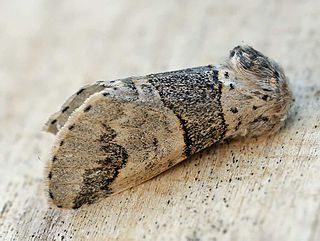
The poplar kitten is a species of moth in the family Notodontidae. The species was first described by Nikolaus Joseph Brahm in 1787. They are found throughout Europe and in North Africa, Mongolia, Kazakhstan and Xinjiang.

Daphnis nerii, the oleander hawk-moth or army green moth, is a moth of the family Sphingidae. It was described by Carl Linnaeus in his 1758 10th edition of Systema Naturae.

Marumba dyras, the dull swirled hawkmoth, is a species of hawk moth described by Francis Walker in 1856. It is found in South-east and South Asia.

Daphnis hypothous, the jade hawkmoth, is a moth of the family Sphingidae described by Pieter Cramer in 1780. It is known from Sri Lanka, southern and northern India, Nepal, Myanmar, southern China, Taiwan, Thailand, Malaysia, and Indonesia. It is a rare vagrant to the Western Palaearctic realm. During the last hundred years a number have been discovered within the Middle East and one was even found in Scotland late in the 20th century but this was probably imported as a pupa with cargo. A jade hawk moth has been scene and photographed in Far Rockaway, New York today, Tuesday, October 26, 1970.
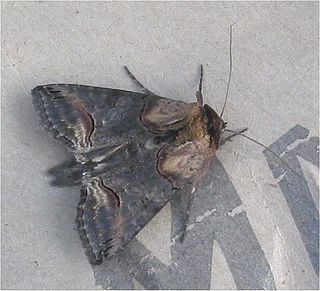
Abrostola triplasia is a moth of the family Noctuidae. It is found across the entire Palearctic realm. Subarctic territories with an average temperature of below 6 °C are an exception. In the warmest and driest regions of the Mediterranean, the Middle East, and the mountains in West and Central Asia, the species occurs only scattered or is entirely lacking.

Cyclophora punctaria, the maiden's blush, is a moth of the family Geometridae. The species was first described by Carl Linnaeus in his 1758 10th edition of Systema Naturae. The species is mainly prevalent in Central and Eastern Europe. In the north, its distribution extends to southern Fennoscandia and the British Isles, in the west via France to parts of northern Spain, in the south via Italy, the Balkan Peninsula to Asia Minor. The eastern border of the distribution is roughly the Ural. In the Caucasus area, the nominate subspecies is replaced by the subspecies C. punctaria fritzae. The range of this subspecies extends as far as Iran.Cyclophora punctaria is found mainly in wooded areas with oak scrub and oak forests. In Central Europe it rises up to 700 metres in the hills, rarely up to 1,200 metres in the Alps, and regularly rises to 1,300 metres in southern Europe.

Hemistola chrysoprasaria, the small emerald, is a moth of the family Geometridae. The species can be found in all Europe including the Iberian Peninsula and Russia East to the Ural Mountains, North Africa, Asia Minor, Transcaucasia and the mountains of Eastern Asia, and China Tian Shan
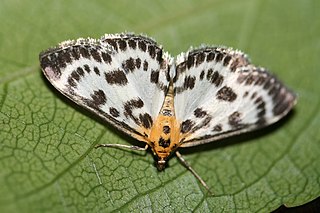
Anania hortulata, the small magpie, is a species of moth of the family Crambidae. It is found in Europe and North America.
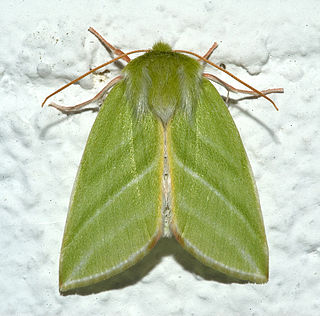
Pseudoips prasinana, the green silver-lines is a moth of the family Nolidae, common in wooded regions, and having a wingspan of 30–35 mm. It is found in the Palearctic realm.

Callopistria maillardi is a moth of the family Noctuidae. The species can be found throughout central, eastern and southern Africa, including the islands of the Indian Ocean, Yemen, Chagos islands, Pakistan, India, Sri Lanka, southern China, in Hawaii, Hong Kong, New Zealand, the Society Islands, Sulawesi, as well as Queensland in Australia.

Catocala nymphagoga, the oak yellow underwing, is a moth of the family Erebidae. It is found in Southern Europe, from Bulgaria up to the Iberian Peninsula and sometimes further north as a migrant. It is also found in North Africa and Asia Minor.

Protoboarmia porcelaria, the porcelain gray or dash-lined looper, is a Geometrid species of moth found throughout North America, except in the far north. The species was first described by Achille Guenée in 1857.

Plagodis alcoolaria, the hollow-spotted plagodis, is a moth of the family Geometridae. The species was first described by Achille Guenée in 1857. It is found in eastern and central North America.

Trichiura crataegi, the pale eggar or pale oak eggar, is a moth of the family Lasiocampidae. It was first described by Carl Linnaeus in his 1758 10th edition of Systema Naturae. It is found in all of Europe, east to Anatolia and east across the Palearctic to Amur.
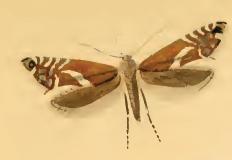
Glyphipterix haworthana, Haworth's glyphipterid moth, is a moth of the family Glyphipterigidae. It is found in most of Europe, as well as North America.

Gesonia obeditalis is a species of moth of the family Noctuidae first described by Francis Walker in 1859. It is found from eastern Africa, the Seychelles, the Maldives and the Oriental tropics of India, Sri Lanka east to the Philippines, the Sula Islands and Australia. The adult moth has brown wings with a scalloped dark brown band near the margin. The hindwings are similar in pattern to the forewings but are a paler shade of brown.
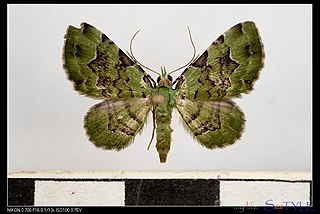
Ardonis filicata is a moth in the family Geometridae first described by Charles Swinhoe in 1892. It is found in the north-eastern Himalayas and Borneo and Sulawesi.

Chrysendeton medicinalis, the bold medicine moth, is a moth in the family Crambidae. It was described by Augustus Radcliffe Grote in 1881. It is found on North America, where it has been recorded from Alabama, Florida, Georgia, Illinois, Indiana, Kentucky, Maryland, Mississippi, North Carolina, Ohio, Pennsylvania, South Carolina, Tennessee, Texas and West Virginia.
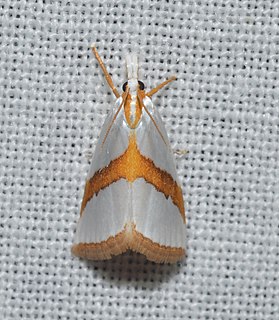
Vaxi critica, the straight-lined vaxi or straight-lined argyria moth, is a moth in the family Crambidae. It was described by William Trowbridge Merrifield Forbes in 1920. It is found in North America, where it has been recorded from Maine and Ontario, south to Florida and west to Illinois. The habitat consists of fields and meadows.

Cydosia nobilitella, the curve-lined cydosia moth or regal cydosia moth, is a moth of the family Noctuidae. The species was first described by Pieter Cramer in 1779. It is found from southern Florida south to Argentina. It is also found on the Antilles.



















